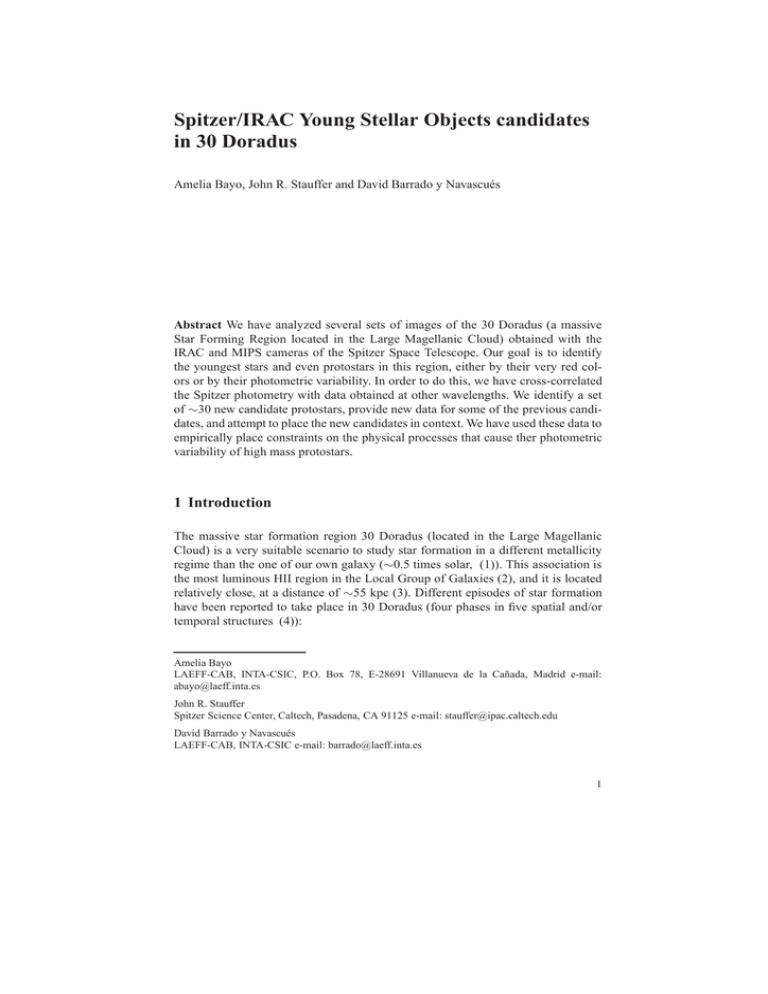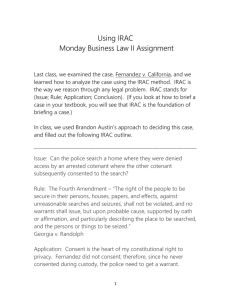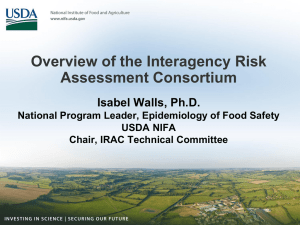Spitzer/IRAC Young Stellar Objects candidates in 30 Doradus
advertisement

Spitzer/IRAC Young Stellar Objects candidates in 30 Doradus Amelia Bayo, John R. Stauffer and David Barrado y Navascués Abstract We have analyzed several sets of images of the 30 Doradus (a massive Star Forming Region located in the Large Magellanic Cloud) obtained with the IRAC and MIPS cameras of the Spitzer Space Telescope. Our goal is to identify the youngest stars and even protostars in this region, either by their very red colors or by their photometric variability. In order to do this, we have cross-correlated the Spitzer photometry with data obtained at other wavelengths. We identify a set of ∼30 new candidate protostars, provide new data for some of the previous candidates, and attempt to place the new candidates in context. We have used these data to empirically place constraints on the physical processes that cause ther photometric variability of high mass protostars. 1 Introduction The massive star formation region 30 Doradus (located in the Large Magellanic Cloud) is a very suitable scenario to study star formation in a different metallicity regime than the one of our own galaxy (∼0.5 times solar, (1)). This association is the most luminous HII region in the Local Group of Galaxies (2), and it is located relatively close, at a distance of ∼55 kpc (3). Different episodes of star formation have been reported to take place in 30 Doradus (four phases in five spatial and/or temporal structures (4)): Amelia Bayo LAEFF-CAB, INTA-CSIC, P.O. Box 78, E-28691 Villanueva de la Cañada, Madrid e-mail: abayo@laeff.inta.es John R. Stauffer Spitzer Science Center, Caltech, Pasadena, CA 91125 e-mail: stauffer@ipac.caltech.edu David Barrado y Navascués LAEFF-CAB, INTA-CSIC e-mail: barrado@laeff.inta.es 1 2 Amelia Bayo, John R. Stauffer and David Barrado y Navascués • The youngest members reported in the literature (mainly zero age main sequence O type stars, less than 1 Myr old) are distributed in dense knots around the central cluster RCM 136a. In particular, an H2 O maser (located to the north-east of RCM 136a) and 11 O-type dwarfs (distributed to the north-east and west of the mentioned cluster) have been detected. • Sources in an ulterior evolutionary stage, ∼3 Myr old, characterized by early Otype stars and WR in the so call WN state, have been detected in the central area of 30 Doradus, including RMC 136a (containing 12 very massive and luminous stars, mainly O3 spectral types with masses ∼37–76M⊙ (5)) • Going further in evolution, a significant population of late-O/early-B supergiants (∼5 Myr) located at the center of 30 Doradus has been proposed by different authors (see (4) and references therein). This stars are less concentrated around the ionizing cluster RMC 136a than the early O dwarfs and WN types and must be older. Also objects around RMC 143 (LBV, (6)), located in the southeast sector of 30 Doradus, are mainly late O and early B (but three early O objects that are supposed to share evolutionary status with the objects described in the previous item), implying a likely coeval association. • Finally, more evolved objects, mid-B/A/M supergiants (implying and age of lower-limit of ∼8Myr) have been proposed in the Northwest Cluster, Hodge 301 association (H88 301). In particular, four M-type supergiants have been found (7; 8) within 3’ radius in this association. The complex evolutionary history of the region provides us with a mixture of stars from ≤ 1 Myr to ≥ 20 Myr, and thus including high mass stars still on pre-main sequence (PMS) tracks as well as other high mass stars that have already left the main sequence and are now red or blue supergiants. 2 Multi-wavelength data 2.1 SPITZER observations The region of 30 Doradus has been observed in the four channels (I1, I2, I3 and I4, centered respectively at 3.6, 4.5, 5.8 and 8.0 µ m) of the Infrared Array Camera (IRAC (10)) on board the Spitzer Space Telescope in three different epochs: • ERO Program #1032, PI: Bernhard Brandl (Nov., 6th 2003) • GTO Program #63, PI: James R. Houck (Dec., 7th 2003) • SAGE Legacy Project #20203, PI: Margaret Meixner (Jul., 22nd & 24th 2005) All the observations were performed in high dynamic range (HDR) mode with integration frames of 0.6 and 12s (with exposure times of 0.4 and 10.4s respectively). The region common to the three observing epochs which we have analyzed ′ ′′ is centered at RA= 05h 39m 01.1s and DEC= −69o04 52.2 with a radius of ∼18 arcmin. Spitzer/IRAC YSOs in 30 Doradus 3 We downloaded the individual basic calibrated data (BCDs) corresponding to each program. We performed the artifact mitigation and masking tasks using the IDL tools provided on the Spitzer contributed website 1 . The corrected individual files were combined into mosaics using the post-BCD MOPEX package (11). As a result, we obtained different products: one mosaic per epoch (to look for variable sources) and an unique, deeper, mosaic of the region (combination of all the data available from all the epochs). The mosaics were constructed in 0.6x0.6 arcsecond pixels-scale (∼half of the native IRAC pixel size). We derived aperture photometry for the sources in our mosaics using DAOPHOT package (in IRAF). We have used a 6 pixel radius aperture (∼3 IRAC native pixels) and sky annulus from 6 to 14 pixels. We have adapted the zero point magnitudes provided in the IRAC data handbook http://ssc.spitzer.caltech.edu/irac/dh/ for the four channels to our pixel scale, we have used the aperture corrections provided in the IRAC data handbook, and we have used the flux for zero magnitude calibration provided in (12). We have estimated our internal 1-σ accuracy per channel by studying the dispersion of the magnitudes calculated for each epoch for a sample of ∼150 stellar-like sources (by stellar-like we mean that they have stellar-like location in the IRAC [3.6] − [4.5] vs. [5.8] − [8.0] color-color diagram). For [3.6] < 13.0, we obtain accuracies of ∼0.02, ∼0.02, ∼0.03 and ∼0.04 mag for channel one, two, three and four, respectively. 2.2 2MASS counterparts Aiming to enlarge our wavelength coverage, we looked for counterparts for our IRAC sources in different resources. As a first step, we cross-matched our IRAC– catalog with the regular, public 2MASS near-infrared survey catalog. Around 73% of the sources had a counterpart in 2MASS in 2.5 arcsec radius. In order to be able to characterize near-infrared properties for the faintest sources, we had access to the 2MASS extended mission 6x data products. This enlarged the number of sources with J, H and Ks counterparts up to ∼76%. 2.3 Other public catalogs We have also made use of other public databases when looking for counterparts for our sources. These databases were mainly DENIS, NOMAD, the MSX point source catalog (four photometric bands centered at 8.28, 12.13, 14.65 and 21.34 microns) and the 24 micron MIPS-LMC catalog produced by the SAGE team. For each case we have used an appropriate depending on the accuracy of the astrometry of the dif1 http://ssc.spitzer.caltech.edu/archanaly/contributed/browse.html 4 Amelia Bayo, John R. Stauffer and David Barrado y Navascués ferent catalogs. We found that ∼15% of the IRAC sources had MIPS counterparts, while only ∼1% (seven sources) were reported in the MSX catalog. Regarding bluer counterparts, ∼70% of our sources had a DENIS counterpart and ∼40% had even V-band counterpart compiled in NOMAD. 3 Photometric properties 3.1 Variability Young stars are known to vary, periodically as well as randomly. Since we were looking for the youngest members of 30 Doradus, we analyzed our three epochs of data looking for variability in the IRAC channels. We have estimated the typical dispersion in the IRAC colors computing the standard deviation of the I1 − I2 and I3 − I4 colors of ∼300 stellar like objects (−0.25 < I1 − I2 < 0.1 √ and −0.15 < I3 − I4 < 0.4) located in our field. The values obtained (divided by 2) are 0.053 (for the first two channels) and 0.088 (for Channels 3 and 4). We have used this values as a threshold (σ ), classifying as variable any objects that show variations larger than 3σ in any of the Channels in at least one epoch. Using this criterion we find: 56 sources showing variability in at least one band. From those sources, only 13 verify our ”variability criteria” for at least three of the four IRAC bands. Nine of this objects have been classified as YSO candidates according to Section 3.2 We found two tendencies in variability in our sample of nine YSO-candidates. On the one hand there are objects were the IRAC colors of the sources remain quite stable in the three epochs. This uniform panchromatic variability can have very different origins; it could be caused by the pulsation of a single object or the presence of spots in the photosphere. On the other hand for objects like ID4386, where there is a clear correlation between the differences in flux and the wavelength, it seem plausible to explain this variability in terms of the presence of a disk around the star (variations in the accretion or inhomogeneities in the disk). 3.2 YSO Candidates Once we combined the three epochs into a deeper image, we analyzed different color criteria available in the literature to establish a tentative YSO classification for the objects in our sample: We tried to take advantage of the multi-wavelength nature Spitzer/IRAC YSOs in 30 Doradus 5 of our database, thus, besides of focusing on IRAC colors, we also used 2MAS J, H and Ks bands as well as MIPS 24 micron photometry (when available). The criteria used were the following: 1. (13), (14) and (15) proposed a classification scheme based on theoretical colors: disk models by (16), and Class I models following (17) and (18)). This scheme leads us to classify 31 sources as Class II, seven as reddened Class II, 62 Class I/II transition source and 68 Class 0/I candidates. 2. (19): reported a color criterion based on the location of various Milky Way templates of evolved stars, Main Sequence stars and Young Stellar Objects. Applying this color cuts, 36 sources are classified as YSOs (all of them already selected Crit 1). On the other hand, 20 sources of those classified as either Class 0, I or II according to our first criterion lie on the area of the diagram dominated by evolved sources. We will use this criteria thus to minimize the possible contamination of evolved sources in our sample. 3. (20) performed a study very similar to ours in the HII region NGC 346 (located in the SMC). Their classification procedure consisted in SED fitting of the sources detected by IRAC in that region. They built a grid of models consisting of stellar atmospheres, infrared spectra from a number of galaxies and AGB stars and the YSOs model grid by (21) (see (20) for further details). They performed an statistical analysis of their fittings and concluded that the [4.5] − [8.0] color is more efficient than the classical [5.8] − [8.0] to distinguish YSOs from galaxies and PAH contaminated SEDs (it enlarges the color baseline and it is sensitive to the abrupt change in YSO spectra between the 4.5 and 5.8 micron bands). In this case, 67 sources from our sample follow their criterion, and 10 of them are new with respect to first and second criteria. On the other hand three of the objects already flagged as possible-contaminant according to the cuts of (19) fall again in the contaminating-source area in this diagram. Besides, 55 other sources (previously classified as YSOs) are flagged as possible galaxies or PAH contaminated SEDs. 4. (22) analyze AKARI data from a region around the supernova remnant G54.1+0.3 and claim to find a population of YSO candidate that would have redder [8.0] − [24] color than expected according to their (relatively) blue [3.6] − [5.8]. Applying their colour cuts, we do not identify any YSO that do not fall in the evolved sources region defined by Crit 2. 5. (23) present slightly different color-magnitude and color-color cuts identify YSO candidates in star forming regions. They combine 2MASS, IRAC and 24µ m MIPS data and provide a method to filter possible contamination sources such as broad and weak line AGNs, star forming galaxies, and possible unresolved blobs of shocked emission. Applying these cuts: ∼100 sources where classified as Class I sources either for IRAC colors or combinations with 2MASS or MIPS photometry, ∼60 lie in the contamination areas of the diagrams of (19) and (20), and the remaining sources had already been selected by the previous criteria. Regarding Class II sources, ∼30 sources were selected as “regular” Class II 6 Amelia Bayo, John R. Stauffer and David Barrado y Navascués sources, while ∼20 followed the cuts assigned to the scheme photosphere + MIPS excess. From the first sample, all candidates but six had already been selected by previous criteria. In the second case, all the sources but three have colors compatible with evolved sources too, thus we have only added those three to our list. We performed color and magnitude cuts to filter possible contaminant sources to our initial list of 200 sources ( (19, 20)) obtaining a final list of 66 YSO candidates. We separate them in two groups: Class I and Class II sources (this latter group includes reddened Class II as well as possible debris disks). For the list of our IRAC sources in the whole field we have calculated the α parameter from (24) which, based on the shape of the IRAC SED, allows to agrupate them depending on their disks properties: disk-less stars, optically thin disks and optically thick ones. Dividing the IRAC catalog in two groups according to their Lada class (disk, any kind, and diskless sources), we see that the distributions of sources in this two groups with respect to the extinction are clearly different; while diskless objects are equally distributed across areas with different Av values, disks sources are much more concentrated in those areas with higher extinction. References 1. 2. 3. 4. 5. 6. 7. 8. 9. 10. 11. 12. 13. 14. 15. 16. 17. 18. 19. 20. 21. 22. 23. 24. P.R. Wood et al, A&A 336, 925 (1998) R.C. Kennicutt, Jr., ApJ 287, 116 (1984). DOI 10.1086/162669 R. Vermeij et al, A&A 382, 1042 (2002). DOI 10.1051/0004-6361:20011628 N.R. Walborn, J.C. Blades, ApJS 112, 457 (1997). DOI 10.1086/313043 P. Massey, D.A. Hunter, ApJ 493, 180 (1998). DOI 10.1086/305126 J.W. Parker et al, ApJ 409, 770 (1993). DOI 10.1086/172706 A.R. Hyland et al, AJ 83, 20 (1978) P.J. McGregor, A.R. Hyland, ApJ 250, 116 (1981). DOI 10.1086/159353 L.K. Townsley et al, AJ 131, 2140 (2006). DOI 10.1086/500532 G.G. Fazio et al, ApJS 154, 10 (2004). DOI 10.1086/422843 D. Makovoz, I. Khan, ASPCS, vol. 347, pp. 81–+ W.T. Reach et al, PASP 117, 978 (2005). DOI 10.1086/432670 L.E. Allen et al, ApJS 154, 363 (2004). DOI 10.1086/422715 L. Hartmann et al, ApJ 629, 881 (2005). DOI 10.1086/431472 S.T. Megeath et al, ApJS 154, 367 (2004). DOI 10.1086/422823 P. D’Alessio et al, in IAU Symposium, vol. 221, pp. 403–+ S.J. Kenyon et al, ApJ 414, 676 (1993). DOI 10.1086/173114 N. Calvet et al, ApJ 434, 330 (1994). DOI 10.1086/174731 M. Meixner et al, AJ 132, 2268 (2006). DOI 10.1086/508185 J.D. Simon et al, ApJ 669, 327 (2007). DOI 10.1086/521544 T.P. Robitaille et al, ApJS 167, 256 (2006). DOI 10.1086/508424 B.C. Koo et al, ArXiv e-prints 712 (2007) R.A. Gutermuth et al, ArXiv e-prints 710 (2007) C.J. Lada et al, AJ 131, 1574 (2006). DOI 10.1086/499808



